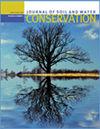Nitrogen balances and losses in conservation cropping systems across a tile-drained landscape in Ohio, United States
IF 2.6
4区 农林科学
Q2 ECOLOGY
引用次数: 0
Abstract
Productions of corn ( Zea mays L.) and soybean ( Glycine max L.) in the midwestern United States are the primary source of nitrogen (N) degrading local and downstream surface waters. Conservation crop rotation involves growing a series of crop phases in a field, reducing fallow periods and enhancing N demand. The objective of this study was to contrast conventional rotations of corn–soybean (CS) with conservation rotations of corn–soybean–winter wheat ( Triticum aestivum L.; CSW) as N management tools using a mass balance approach. We calculated N balances (∑Inputs – ∑Outputs) and loads, as both nitrate-N (NO3−-N) and total N (TN), for fields with CS ( n = 18) and CSW ( n = 12) rotations to examine crop- and rotation-specific patterns of N surplus, deficit, and loss. Using data from all individual years ( n = 169), we found median N balance indicated surplus N in corn phases (CSW-corn: 112 kg N ha−1; CS-corn: 51 kg N ha−1) compared to N deficits in wheat (−1.3 kg N ha−1) and soybean (CS-soybean: −110 kg N ha−1; CSW-soybean: −92 kg N ha−1) phases. Median N loss was least in wheat (8 kg NO3−-N ha−1; 11 kg TN ha−1) and soybean phases (CS-soybean: 18 kg NO3−-N ha−1, 21 kg TN ha−1; CSW-soybean: 17 kg NO3−-N ha−1, 23 kg TN ha−1) and greatest in corn phases (CS-corn: 31 kg NO3−-N ha−1, 35 kg TN ha−1; CSW-corn: 27 kg NO3−-N ha−1, 34 kg TN ha−1). The median of average annual N balance was greater in CSW (14 kg N ha−1) than CS fields (−29 kg N ha−1), yet the medians of average annual N loss were similar (e.g., CSW: 19 kg NO3−-N ha−1; CS: 22 kg NO3−-N ha−1). These results suggest that including winter wheat into the CS rotation may have the potential to address N surplus pools and reduce N loss to downstream waters.美国俄亥俄州瓦片排水景观中保护性耕作系统的氮平衡和损失
美国中西部的玉米(Zea mays L.)和大豆(Glycine max L.)是造成当地和下游地表水氮(N)退化的主要来源。保护性轮作包括在田间种植一系列作物,减少休耕期,提高氮需求量。本研究的目的是采用质量平衡法,将玉米-大豆(CS)的常规轮作与玉米-大豆-冬小麦(Triticum aestivum L.; CSW)的保护性轮作作为氮管理工具进行对比。我们计算了CS(n = 18)和CSW(n = 12)轮作田的氮平衡(∑输入-∑输出)和负荷(硝酸盐-氮(NO3--N)和总氮(TN)),以研究作物和轮作特有的氮盈余、亏损和损失模式。利用所有年份(n = 169)的数据,我们发现氮平衡中位数表明玉米阶段(CSW-玉米:112 千克氮公顷-1;CS-玉米:51 千克氮公顷-1)氮过剩,而小麦(-1.3 千克氮公顷-1)和大豆(CS-大豆:-110 千克氮公顷-1;CSW-大豆:-92 千克氮公顷-1)阶段氮不足。小麦(8 千克 NO3--N 每公顷-1;11 千克 TN 每公顷-1)和大豆(CS 大豆:18 千克 NO3--N 每公顷-1,21 千克 TN 每公顷-1;CSW 大豆:17 千克 NO3--N 每公顷-1,23 千克 TN 每公顷-1)阶段的氮损失中值最小,而玉米阶段的氮损失中值最大(CS 玉米:31 千克 NO3--N 每公顷-1,35 千克 TN 每公顷-1;CSW 玉米:27 千克 NO3--N 每公顷-1,34 千克 TN 每公顷-1)。CSW 田的年均氮平衡中位数(14 千克氮公顷-1)高于 CS 田(-29 千克氮公顷-1),但年均氮损失中位数相似(例如,CSW:19 千克 NO3--N 公顷-1;CS:22 千克 NO3--N 公顷-1)。这些结果表明,在 CS 轮作中种植冬小麦有可能解决氮过剩问题,并减少下游水域的氮流失。
本文章由计算机程序翻译,如有差异,请以英文原文为准。
求助全文
约1分钟内获得全文
求助全文
来源期刊
CiteScore
4.10
自引率
2.60%
发文量
0
审稿时长
3.3 months
期刊介绍:
The Journal of Soil and Water Conservation (JSWC) is a multidisciplinary journal of natural resource conservation research, practice, policy, and perspectives. The journal has two sections: the A Section containing various departments and features, and the Research Section containing peer-reviewed research papers.

 求助内容:
求助内容: 应助结果提醒方式:
应助结果提醒方式:


